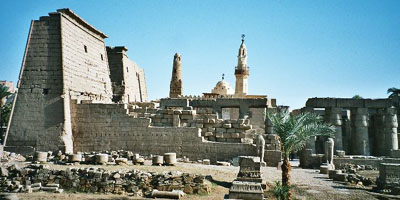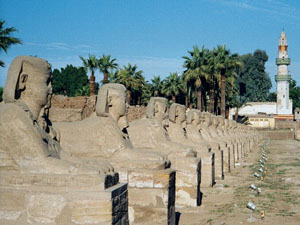Luxor Temple
 |
| Luxor Temple, from the east bank of the Nile |
Luxor Temple is a large Ancient Egyptian temple complex
located on the east bank of the River Nile in the city today
known as Luxor (ancient Thebes).
Known in the Egyptian language as ipet resyt, or
"the southern harem", the temple was dedicated to the Theban
Triad of Amun, Mut, and Chons and was, during the New Kingdom,
the focus of the annual Opet Festival, in which a cult statue
of Amun was paraded down the Nile from nearby Karnak Temple
(ipet-isut) to stay there for a while, with his consort Mut,
in a celebration of fertility – whence its name.
Description
Access to the temple was – and still is, for the
thousands of tourists who flock there every day – from the
north, where a causeway lined by sphinxes that once led all
the way to Karnak begins; this road was a later addition,
dating from the time of Nectanebo I in the 30th Dynasty.
The temple proper begins with the 24 metre (79 ft)
high First Pylon, built by Ramesses II. The pylon was decorated
with scenes of Ramesses's military triumphs (particularly
the Battle of Kadesh); later pharaohs, particularly those
of the Nubian and Ethiopian dynasties, also recorded their
victories there. This main entrance to the temple complex
was originally flanked by six colossal statues of Ramesses
– four seated, and two standing – but only two (both seated)
have survived. Modern visitors can also see a 25 metre (82
ft) tall pink granite obelisk: this one of a matching pair
until 1835, when the other one was taken to Paris where it
now stands in the centre of the Place de la Concorde.
Through the pylon gateway leads into a peristyle
courtyard, also built by Ramesses II. This area, and the pylon,
were built at an oblique angle to the rest of the temple,
presumably to accommodate the three pre-existing barque shrines
located in the northwest corner. It is atop the columns of
this courtyard that the Abu Haggag mosque was built: on the
eastern side, a doorway leads surrealistically out into thin
air some 8 metres (26 ft) above the ground.
 |
Hundreds of sphinxes once lined
the road to nearby Karnak
|
After the peristyle courtyard comes the processional
colonnade built by Amenhotep III – a 100 metre (328 ft) corridor
lined by 14 papyrus-capital columns. Friezes on the wall describe
the stages in the Opet Festival, from sacrifices at Karnak
at the top left, through Ammon's arrival at Luxor at the end
of that wall, and concluding with his return on the opposite
side. The decorations were put in place by Tutankhamun: the
boy pharaoh is depicted, but his names have been replaced
with those of Horemheb.
Beyond the colonnade is a peristyle courtyard, which
also dates back to Amenhotep's original construction. The
best preserved columns are on the eastern side, where some
traces of original colour can be seen. The southern side of
this courtyard is made up of a 32-column hypostyle court that
leads into the inner sanctums of the temple.
These begin with a dark antechamber. Of particular
interest here are the Roman stuccoes than can still be seen
atop the Egyptian carvings below; in Roman times this area
served as a chapel, where local Christians were offered a
final opportunity to renounce their faith and embrace the
state religion. Moving further in stands a Barque Shrine for
use by Amun, built by Alexander, with the final area being
the private quarters of the gods and the Birth Shrine of Amenhotep
III (his divine origin is depicted in precise, almost touching
detail on the walls).
A cache of 26 New Kingdom statues was found under
the floor in the inner sanctum area in 1989 – hidden away
by pious priests, presumably, at some moment of internal upheaval
or invasion. These splendid pieces are now on display at the
nearby Luxor Museum.